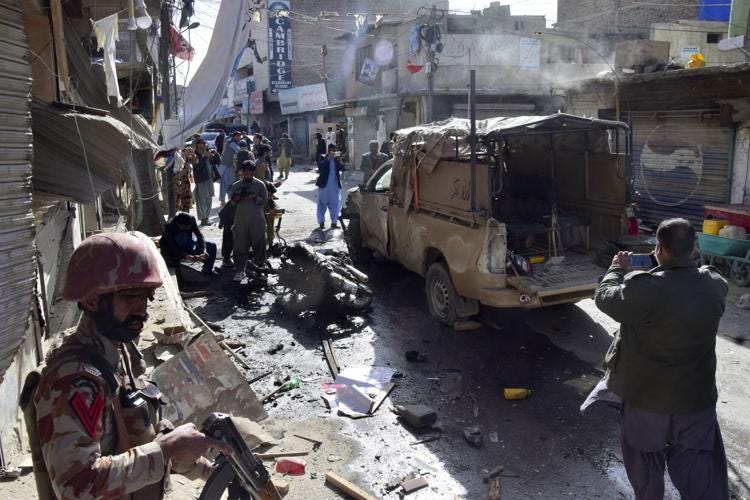Did Pakistan’s Military Have a Hand in the Nowshera Mosque Attack?
Echoes of Conspiracy
The tragic suicide bombing at Darul Uloom Haqqania in Akora Khattak, Nowshera, on February 28, 2025, has raised serious questions. While initial reports suggested Islamic State Khorasan Province (IS-K) as the likely perpetrator, some analysts and political observers have pointed toward an alternative, controversial theory: Was Pakistan’s military involved?
This notion stems from Pakistan’s historical use of militant networks for strategic purposes, internal factional struggles, and covert operations. While there is no direct evidence implicating the military, the attack’s timing, target, and geopolitical implications provide fuel for speculation. Here’s why some might suspect military involvement.
1. The History of Proxy Warfare and Military-Militant Nexus
Pakistan’s military and intelligence agencies—particularly the Inter-Services Intelligence (ISI)—have a long-documented history of leveraging militant groups for strategic objectives. This strategy has played out in Afghanistan, Kashmir, and even within Pakistan’s borders.
The Darul Uloom Haqqania seminary has been instrumental in producing key figures of the Afghan Taliban, a group that has historically enjoyed the backing of Pakistani intelligence.
However, Pakistan’s relationship with militant groups is not monolithic; while some factions remain loyal, others, like Tehrik-i-Taliban Pakistan (TTP), have turned against the state.
Given Haqqania’s ideological influence over Taliban-aligned groups, an internal military purge to eliminate figures no longer seen as assets cannot be ruled out.
2. Internal Power Struggles: A Purge Within Islamist Networks?
The attack at Haqqania raises concerns about an internal power struggle within Pakistan’s Islamist landscape. Maulana Hamid Ul Haq Haqqani, who was killed in the blast, was the son of Maulana Sami-ul-Haq, the so-called ‘Father of the Taliban’, who himself was assassinated in 2018 under mysterious circumstances.
If the military saw Hamid Ul Haq as a potential obstacle to shifting alliances or an emerging liability, his removal through a plausibly deniable terrorist attack would align with past patterns of targeted eliminations.
3. The Benazir Bhutto Connection: The Shadow of Musharraf
Another significant aspect fueling speculation is Darul Uloom Haqqania’s alleged connection to the assassination of former Prime Minister Benazir Bhutto in 2007. Investigations into her killing revealed that her assassination was planned at this very seminary, allegedly by militants linked to Baitullah Mehsud and Tehrik-i-Taliban Pakistan (TTP).
Former President Pervez Musharraf has often been accused of either allowing or facilitating Bhutto’s assassination, as she posed a political threat to the military establishment.
Bhutto had repeatedly warned of threats from elements within Pakistan’s security apparatus and had even named Musharraf as someone responsible for her safety should anything happen to her.
The fact that another attack has now occurred at the same location raises pressing questions about whether a similar state-backed game is being played again.
4. Warning to the Afghan Taliban and Control Over Madrassas
The attack could also serve as a message to the Afghan Taliban. While Pakistan initially welcomed the Taliban’s return to power in 2021, tensions have since grown, particularly over border security and militant spillover into Pakistan.
Haqqania has historically been a pipeline for Taliban recruitment, making it an influential player in Pakistan’s dealings with the Afghan Taliban.
If Pakistan’s military wanted to pressure or discipline the Taliban, attacking a symbolic madrassa linked to their ideological roots could serve as a warning.
The rise of Islamic State-Khorasan (IS-K) has also complicated matters; Pakistan could use an attack like this to justify a security crackdown on certain madrassas while shifting blame onto IS-K.
5. The False Flag Theory: Justifying a Crackdown?
Pakistan’s intelligence agencies have, in the past, been accused of false flag operations—attacks orchestrated by state actors to justify military actions or shift blame onto adversaries.
In 2014, the Army Public School (APS) attack in Peshawar was blamed on the TTP, but some independent analysts suggested possible state negligence or even manipulation to justify a full-scale military offensive in tribal areas.
If the Nowshera attack was a pretext to justify a renewed military crackdown on militant elements perceived as a threat, it would not be the first time such tactics were used.
The timing—just before Ramadan and amid a growing Taliban-TTP conflict—raises questions about who benefits from this attack.
6. ISI’s Reputation for Covert Operations
Pakistan’s deep state has been involved in numerous clandestine operations that shape the country’s political and security landscape. Some examples include:
The forced disappearances of activists and journalists critical of military policies.
The elimination of political figures deemed threats to the establishment, such as former Prime Minister Benazir Bhutto, whose assassination in 2007 was linked to jihadist networks allegedly operating with state complicity.
The mysterious deaths of pro-Taliban clerics, including Sami-ul-Haq in 2018.
The ISI has both the operational capability and historical precedent to carry out covert eliminations under the guise of terror attacks.
7. The Lack of a Clear Claim of Responsibility
Unlike typical terrorist attacks where groups like IS-K or TTP promptly claim responsibility, the Nowshera bombing remains officially unclaimed. This leads to several possibilities:
A calculated operation where the perpetrators wish to remain in the shadows.
A rogue faction within the military or intelligence community eliminating figures no longer deemed useful.
A complex multi-player game where responsibility is deliberately obfuscated.
Conclusion: A Case for Further Investigation
While no direct evidence implicates Pakistan’s military, history shows that targeted killings, covert operations, and strategic eliminations are not uncommon in the country’s security playbook. The absence of a clear claim of responsibility, the attack’s timing, and Haqqania’s political relevance all contribute to speculation.
If the attack was indeed engineered from within, it would point to a deepening crisis within Pakistan’s power structure—one where factions within the establishment are at odds over the country’s militant policy.
Only an independent and transparent investigation can reveal the true motives behind the Nowshera attack. Until then, the question remains: Was this merely another act of terrorism, or a well-executed power move from within the state’s shadowy corridors?



